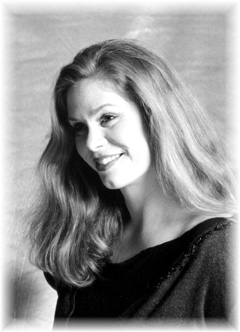The Doctor Is In: An Interview with Laura Schrader-Johnson

The new UMB technical director, Laura Schrader-Johnson.
September 18, 2002
It’s all about the art. At least that’s the perspective that Laura Schrader-Johnson (“Doctor Laura”) takes in her approach to all points on the theatre compass. She’s one of the newest additions to the Performing Arts faculty and this is her first semester at UMass Boston, where she is the resident technical director for the Theatre Program.
MY: So why ‘Doctor Laura’?
LSJ: That’s been pinned on me thanks to some hopefully more obscure radio show host called ‘Doctor Laura,’ so it’s starting to stick a little bit. I’m not sure how I feel about it yet. It’s short, it’s easy, but maybe the ‘Doctor’ will be dropped and people will call me Laura.
MY: Why ‘Doctor’ in the first place?
LSJ: I have a doctorate in law.
MY: Why?
LSJ: There’s definitely a certain synergy between law and theatre.
MY: So how did you get into theatre?
LSJ: Let’s see…I got into theatre growing up as a child in Stratford, Connecticut, home of the American Shakespeare Theatre where many of the greatest Shakespearean actors tread the boards. So I had quite an education from going there summer after summer. I interned there in high school while I performed in other theatres.
I majored in theatre at Fordham University in Lincoln Center in Manhattan, where I studied acting and scenic design. I also began directing. By the time I graduated, I also had a minor in art and an interest in film and video. I actually began working in those fields for years as an assistant director and as a producer.
MY: Make any movies?
LSJ: I mainly worked in videos and commercials.
MY: Have we seen any of them?
LSJ: Probably. Wait a second! (laughing) You’re too young. I refuse to date myself in any way.
MY: How did you get into law?
LSJ: I was doing more and more producing work and originally had the intention of staying in the film industry and moving into producing or features. I got a scholarship to University of Bridgeport School of Law, which is now Quinnipeac University. The name actually changed after I graduated so I have two diplomas, two law degrees.
MY: Two for the price of one. What did you do with your degree(s)?
LSJ: By the time I finished my years in law school, I got sucked into the practice of law, conventional law. You kind of lose touch with your artist friends [during] law school. I went into corporate law and became a corporate counsel for a software company. That’s how I ended up moving to Boston. I hung up my hat and got back into theatre, which is my love and that was several years ago.
MY: Where else do you work?
LSJ: My home away from home, outside of UMass which is becoming my home (laughs), is the Foot Light Club in Jamaica Plain. It’s an incredible historic theatre…built in the 1800s, right at the end of Centre Street. It’s all volunteer [work]. It’s been continuously operated as a ‘footlight club’ for 128 years.
MY: What is the idea behind a ‘footlight club’?
LSJ: That was the original name in the Victorian period. A group of people got together and said, ‘Hey, let’s start a dramatic club.’ It is still honoring the tradition. They kept the name. It sounds exclusive but it is a community theatre open to everyone. I’m scenic arts manager there, have directed there, and acted there in the past. I’ll be directing A Streetcar Named Desire there in the spring.
MY: (yelling) Stella!
LSJ: (laughing) I’m hoping to involve students from UMass in an alternative theatre they can work at building sets for lab hours, other assorted projects they can do on the show. They can apprentice with different areas on the show. They have a professional soundman on the show.
MY: What else is on the agenda for fall?
LSJ: Look for that for spring, oh and I’m taking that to EMACT.
MY: ‘EMACT’?
LSJ: Eastern Massachusetts Association of Community Theatres. It is arguably the largest association of community theatres in the country and it’s only for the eastern half of Massachusetts because the Boston area is so rich in high-level community theatres. It’s just unbelievable. There’s no place like Boston for theatre you can do part-time.
It’s part of a national circuit. There’s state, regional, international, etc. It’s held every year at Brandeis University. All the actors have to be amateur. We cleaned up last year. I can take students and put them on the crew. There are nationals every two years. We’re lucky. If we make it to nationals, it’s right in Connecticut.
MY: What’s your favorite: you do scenic design, lighting, directing?
LSJ: I love to design lighting, especially for festival plots, artistically. But I have a fear of heights.
MY: Then how do you design sets?
LSJ: I had to go to the top of a three-story set for Death of Salesman. I’ll do it out of necessity but I don’t choose to do it. You get better. You do it a few times and it stops [being scary].
I love directing. I generally design the set when I direct. I see the show as a whole artistically: the acting style, the time and the place, the set design, the costume design, even props. I tend to do things with a unified color scheme.
MY: What originally brought you to UMass?
LSJ: It was the perfect combination. The department was looking for someone to raise the artistic bar in the area of set design, as well as directing.
MY: What are you teaching here?
LSJ: Theatre Crafts and Acting I. Theatre Crafts is where students learn the basics of set design. Future designers or directors or actors need to understand the concepts, how it comes about, how it works, so they know how to act on it or know how it’s feasible. They actually build the sets. I like doing the combination.
I have a background not typically found. I’m an artist, a director, and an actor. I can come at it from many different directions. I try to take it to the highest artistic limit that it can rather than a purely mechanical function. ‘Let’s build a big clunky series of platforms in wood and hope it looks like what we intended it to look like.’ I approach scenic design first and foremost as an artist. It should be one element…in a unified concept.
MY: Thanks for taking the time to talk to us.
LSJ: It was no problem.





















































